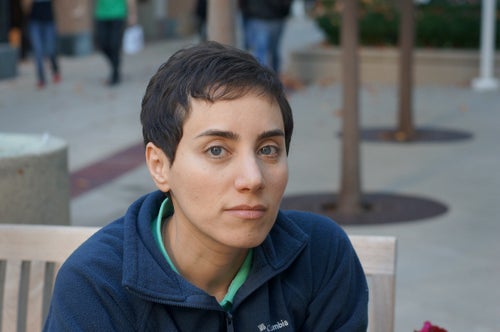An Iranian professor who was the first and only woman to win the mathematics equivalent of the Nobel Prize has continued to smash taboos even after her death.
Maryam Mirzakhani, a Stanford University professor who battled breast cancer, died on Saturday, the university announced.
Iranian media reported the Tehran-native’s death, with several newspapers publishing front page pictures of her without the traditional head-covering.


Wearing the hijab has been compulsory since the 1979 Revolution and the lack of it is punishable by fines, imprisonment or lashes.
In 2014 Mirzakhani was one of four winners of the Fields Medal, which is presented every four years and is considered the mathematics equivalent of the Nobel Prize. She was named for her work on complex geometry and dynamic systems.
The Guardian points out that at the time Iranian newspapers digitally retouched photographs of Mirzakhani to include a hijab over her head, while others published sketches showing only her face.
President Hassan Rouhani paid tribute to her by posting a photograph of her to Instagram, with her hair uncovered. He wrote: “The grievous passing of Maryam Mirzakhani, the eminent Iranian and world-renowned mathematician, is very much heartrending.”
A statement from Stanford announcing the death said: “Mirzakhani specialized in theoretical mathematics that read like a foreign language by those outside of mathematics: moduli spaces, Teichmüller theory, hyperbolic geometry, Ergodic theory and symplectic geometry.
“Mastering these approaches allowed Mirzakhani to pursue her fascination for describing the geometric and dynamic complexities of curved surfaces-spheres, doughnut shapes and even amoebas - in as great detail as possible.”
The work had implications in fields ranging from cryptography to “the theoretical physics of how the universe came to exist,” the university said.
Mirzakhani was born in Tehran, Iran, and studied there and at Harvard University. She joined Stanford as a mathematics professor in 2008.
The 40-year-old originally dreamed of becoming a writer but then shifted to mathematics.
When she was working, Mirzakhani would doodle on sheets of paper and scribble formulas on the edges of her drawings, leading her daughter to describe the work as painting, according to the Stanford statement.
Mirzakhani once described her work as “like being lost in a jungle and trying to use all the knowledge that you can gather to come up with some new tricks, and with some luck you might find a way out.”
Stanford President Marc Tessier-Lavigne called Mirzakhani a brilliant theorist who made enduring contributions and inspired thousands of women to pursue math and science.
Mirzakhani is survived by her husband, Jan Vondrák, and daughter, Anahita.